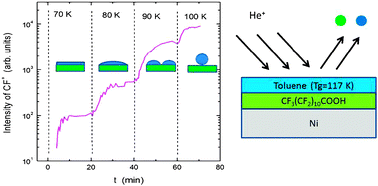The glass transition temperature (Tg) of thin films is reduced by nanoconfinement, but it is also influenced by the free surface and substrate interface. To gain more insights into their contributions, dewetting behaviors of n-pentane, 3-methylpentane, and toluene films are investigated on various substrates as functions of temperature and film thickness. It is found that monolayers of these molecules exhibit sub-Tg dewetting on a perfluoro-alkyl modified Ni substrate, which is attributable to the evolution of a 2D liquid. The onset temperature of dewetting increases with film thickness because fluidity evolves via cooperative motion of many molecules; sub-Tg dewetting is observed for films thinner than 5 monolayers. In contrast, monolayers wet substrates of graphite, silicon, and amorphous solid water until crystallization occurs. The crystallites exhibit autophobic dewetting on the substrate covered with a wetting monolayer. The presence of premelting layers is inferred from the fact that n-pentane crystallites disappear on amorphous solid watervia intermixing. Thus, the properties of quasiliquid formed on the crystallite surface differ significantly from those of the 2D liquid formed before crystallization.

You have access to this article
 Please wait while we load your content...
Something went wrong. Try again?
Please wait while we load your content...
Something went wrong. Try again?


 Please wait while we load your content...
Please wait while we load your content...